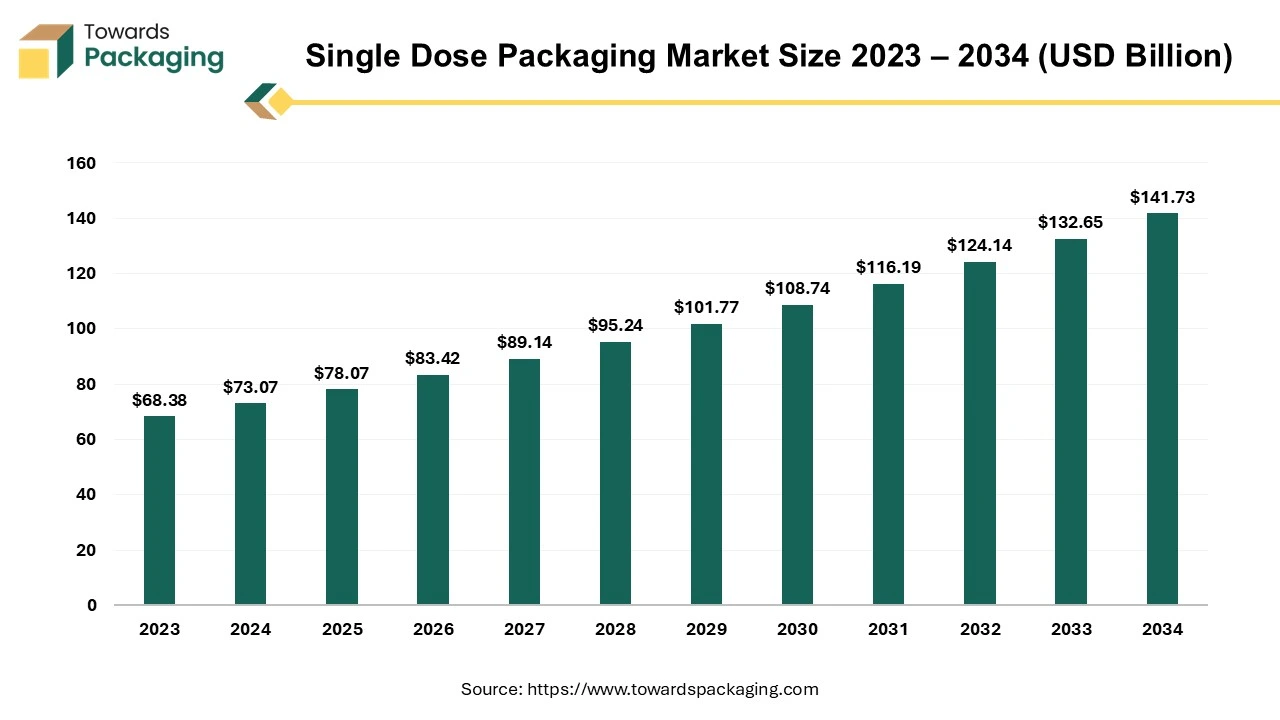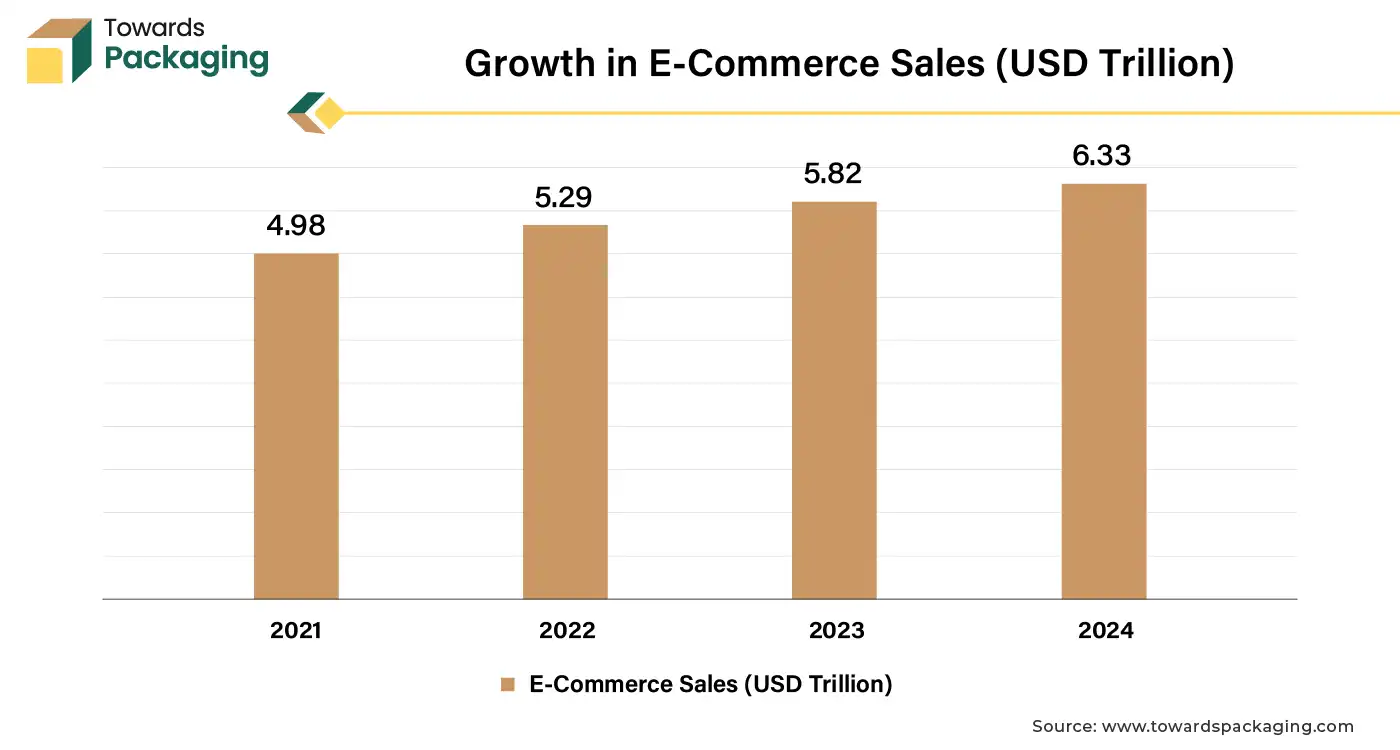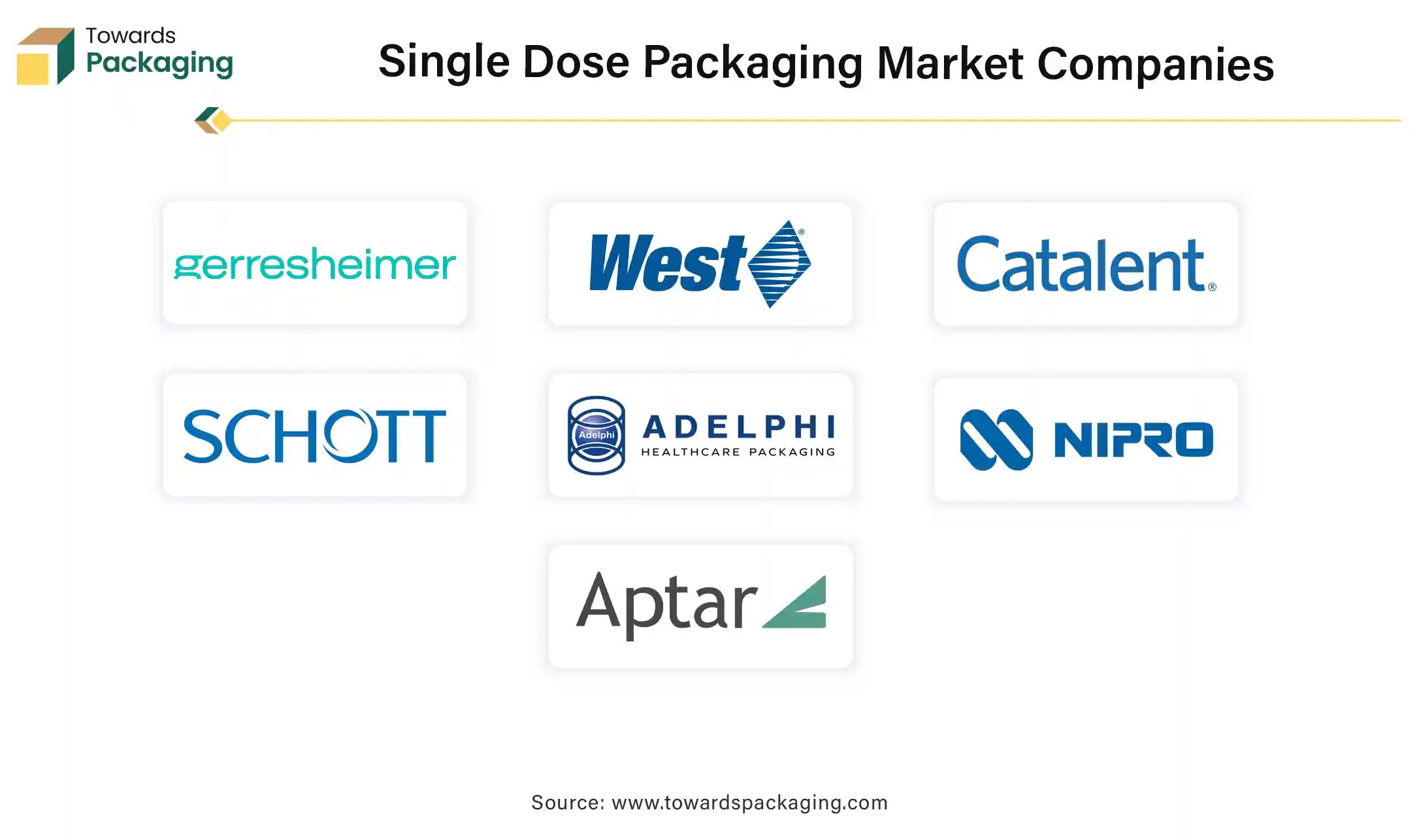November 2025
The single dose packaging market is forecasted to expand from USD 78.07 billion in 2025 to USD 141.73 billion by 2034, growing at a CAGR of 6.85% from 2025 to 2034.

The key players operating in the market are focused on adopting inorganic growth strategies like acquisition and merger to develop advance technology for manufacturing single dose packaging which is estimated to drive the global single dose packaging market over the forecast period.
The packaging formats that contain only one unit or serving of a product, designed to be consumed or used in a single application is known as single dose packaging. This form of packaging is used for a wide range of products across various industries, including pharmaceuticals, healthcare, personal care, food, and even cleaning products. The main goal of single dose packaging is to provide consumers with convenience, accuracy, and ease of use while maintaining product integrity.
Single dose packaging plays a vital role in enhancing product accessibility, accuracy, and convenience across a variety of industries. Whether it's pharmaceutical medications, food products, or personal care items, single dose formats provide numerous benefits to both manufacturers and consumers. However, the growing emphasis on sustainability, cost-efficiency, and regulatory compliance will continue to shape the evolution of single dose packaging solutions in the coming years.
The key features of single dose packaging are pre-measured portions, convenience and portability, tamper evidence, safety and protection from contamination. Single dose packaging provides a barrier to protect the product from contaminants like light, air, bacteria and moisture, which is especially important for products like medications and food.
One of the most significant advantages is the ease of use. Consumers can access a pre-measured dose without the need for additional measuring devices, reducing potential errors and making the product easier to consume or apply. Single dose packaging is ideal for travel and on-the-go use. Products like single-serving beverage sachets, travel-size lotions, or medication packs are all designed to be compact and easy to carry.
Many single dose packages are designed to preserve product integrity by providing a barrier against moisture, air, and light, thereby extending the shelf life of products, especially those that are sensitive to environmental factors. Single dose packaging often includes tamper-evident features, offering consumers assurance that the product has not been altered or contaminated. This is particularly crucial in industries like pharmaceuticals, food, and personal care.
Rising emphasis on utilizing biodegradable, recyclable, or compostable materials for single-dose packaging, driven by consumer demand for environmentally friendly options. This trend is especially prominent in sectors like food and beverages, cosmetics, and pharmaceuticals. In response to environmental concerns and regulatory pressures, companies are exploring alternatives to plastic, such as plant-based paper, glass, and materials.
With the increase of the Internet of Things (IoT), packaging is becoming more intelligent. For instance, single-dose packaging is now being integrated with QR codes, augmented reality (AR), and RFID technology to provide consumers with additional information, promote engagement, or ensure product authenticity.
Lightweight, flexible, and tamper-evident packaging technologies are being developed to improve the user experience and extend the shelf life of products. This includes technologies like vacuum sealing and modified atmosphere packaging (MAP).
Companies are increasingly offering customized or personalized single-dose products, particularly in industries like beauty, skincare, and dietary supplements, to meet the unique needs of consumers.
There is a rise in demand for single-dose packaging in health-related sectors, particularly for vitamins, supplements, and pharmaceuticals. Single-dose packs allow for easy tracking of dosage and minimize the risk of misuse.
Subscription box services, particularly in beauty, food, and health products, are increasingly utilizing single-dose packaging to deliver curated items conveniently to consumers’ doorsteps on a recurring basis.
The integration of artificial intelligence improves the sustainability, cost-effectiveness, and efficiency. The integration of the artificial intelligence helps in design optimization. The artificial intelligence assists in analyzing various material properties (e.g., strength, environmental impact, flexibility) and recommend the suitable materials for single-dose packaging. This can lead to lighter, more sustainable options that reduce costs and waste.
AI-driven design tools can help optimize the layout of packaging, ensuring that single doses are as compact as possible without compromising product integrity. This could reduce material usage and improve shelf space utilization. AI can be used to predict when packaging machinery might fail or require maintenance, minimizing downtime and improving the overall efficiency of the production process. AI-powered vision systems can automatically inspect packaging for defects such as incorrect sealing, misprints, or material flaws, ensuring that only high-quality products reach consumers.
After the Covid-19 breakdown people started preferring online purchasing of goods to avoid spread of infection. The ecommerce platform initiated to offer safe and best service, which attracted more amount of customers. The rise of online shopping increases the demand for smaller, individually packaged products. The surge in online shopping has led to increased demand for smaller packaging formats that are suitable for shipping and handling. Single dose packaging aligns well with this trend.
Retail media ad expenditure in the United States is expected to rise by an astounding 22.5% in the upcoming year i.e., 2025, reaching an incredible $55.31 billion. But maintaining this increasing trend will need coordinated efforts from advertisers and retailers. Retail Media Networks (RMs) must use standardized assessment procedures in order to sustain this rapidly expanding expansion. This proactive measure increases e-commerce traffic growth and helps advertisers accurately evaluate campaign results across many networks.

The key players operating in the market are facing issue in obtaining raw material as well as has safety and health concerns which may restrict the growth of the single dose packaging market over the forecast period. The rising awareness regarding plastic waste and environmental sustainability poses challenges for single-dose packaging. Consumers and regulatory bodies are increasingly advocating for eco-friendly packaging solutions, prompting a shift toward biodegradable materials or bulk packaging. In certain sectors, particularly pharmaceuticals, there may be apprehension regarding the integrity and safety of products in single-dose packages, especially if they do not maintain efficacy or quality over time. Increasing consumer preference for reusable packaging solutions as part of sustainability initiatives can pose a challenge to the growth of single-dose options.
Globally, the chemical sector is widely recognized for being the primary facilitator of economic expansion. Chemical industry products enable everything from the omnipresent cellphone to solar panels that generate carbon-free energy and LED lights that provide efficient lighting. The usage of single dose packaging is done in the chemical sector to store thermoformed products. Sealants, adhesives, modifiers and additives can be stored in convenient single dose package.
BASF SE, Dow Chemical Company, Energizer Holdings Inc., LG Chemicals, and Jax Wax Inc., manufactured several chemical solvents that are utilized in the automotive industry. These products are required to be stored with care so that their oxygen barrier properties are not changed.
Manufacturers worldwide are concentrating on cutting down on chemical waste through effective product packaging. By using one-time packaging, single dose packaging helps prevent chemical waste. In comparison to bulk containers, it is also easier to handle.
The plastic segment held a dominant presence in the single dose packaging market in 2024. The plastic is extensively utilized for manufacturing single-dose packaging due to its efficiency, practicality and versatility. Plastic is inexpensive to produce, especially in large quantities, making it an affordable choice for manufacturers. Its low weight reduces shipping and handling costs and makes it convenient for consumers to carry. Plastic can be molded into various shapes, sizes, and designs, making it suitable for innovative and user-friendly packaging solutions. These properties make plastic an ideal material for single-dose packaging across industries such as pharmaceuticals, personal care, and food.
The solid segment accounted for a considerable share of the market in 2024. Solid forms, such as tablets, capsules, or powders, are less prone to degradation compared to liquid forms. They are more stable and less susceptible to environmental factors like temperature and moisture. Many consumers prefer solid formats for ease of use, particularly for medications or supplements that are taken orally. These factors collectively make the solid form segment a dominant player in the single-dose packaging market, particularly in industries like healthcare, personal care, and food supplements.
On the other hand, the liquid segment is expected to grow at the fastest rate in the single dose packaging market during the forecast period of 2024 to 2034. In pharmaceutical sector, sweetening and flavouring chemicals can be used to cover up the bad taste of the medications. it has positive psychological impacts and is visually appealing. the medication can be absorbed quickly.
The blister packaging segment registered its dominance over the global single dose packaging market in 2024. Blister packaging provides excellent protection against oxygen, light, moisture, and contamination, making sure the efficacy and stability of medications. Blister packs allow for precise, single-dose dispensing, which is critical for ensuring patient safety and compliance.
It eliminates the risk of over- or under-dosing, especially for over-the-counter or self-administered medications. Blister packaging is highly compatible with automated filling and sealing machines, improving manufacturing efficiency and reducing human error.
The vials segment is expected to grow at the fastest rate in the single dose packaging market during the forecast period of 2024 to 2034. Vials offer a hermetically sealed environment, preventing contamination and ensuring sterility. Vials are extensively utilized for single-dose packaging, particularly in the pharmaceutical and healthcare industries, due to their unique benefits and suitability for liquid and injectable medications.
The pharmaceutical segment dominated the single dose packaging market globally. With the growth of the pharmaceutical sector, there is a rise in the production of medications for chronic and acute diseases, many of which are suitable for single-dose packaging to ensure accurate dosing. Single-dose packaging aligns with the pharmaceutical industry's need for precise dosing, reducing the risk of overdose or underdose. It also minimizes contamination and ensures product integrity.
As pharmaceutical regulations increasingly emphasize safe, tamper-evident, and sterile packaging, single-dose formats meet these requirements effectively, driving adoption. New drug formulations, including biologics and highly sensitive compounds, often require specialized single-dose packaging to protect against degradation and maintain efficacy.
The North America region held a significant share of the single dose packaging market in 2024. Single-dose packaging offers convenience for consumers who seek easy-to-use, portable products. This is particularly attractive in fast-paced lifestyles where on-the-go consumption is common, such as with food, beverages, pharmaceuticals, and personal care products. As online shopping continues to rise, single-dose packaging is ideal for e-commerce, where smaller, individual-sized items are easier to ship, handle, and store.
This is especially true in the beauty, health, and wellness industries. While single-dose packaging has been critiqued for generating waste, there is a growing trend toward eco-friendly materials and biodegradable options. North American consumers are increasingly demanding sustainable solutions, pushing companies to innovate in ways that align with environmental concerns.
Asia Pacific region is projected to host the fastest-growing single dose packaging market in the coming years. Asia Pacific is home to over 4.7 billion people, with many countries like China, India experiencing rapid population growth and aging demographics. As populations increase and age, there is a higher demand for medications, healthcare services, and treatments. Asia Pacific region is seeing an increase in lifestyle-related diseases such as cardiovascular diseases, diabetes, and cancer, as well as infectious diseases. These health challenges create a growing need for pharmaceutical products and treatments. Additionally, the demand for specialized medications, such as those for rare diseases or oncology, is rising.
According to the data published by the World Health Organization in March 2023, about 25 million people in India are prediabetics, meaning they have a higher chance of getting diabetes in the near future, while an estimated 77 million adults over the age of 18 have type 2 diabetes. Over half of the population is not aware that they have diabetes, which can cause health issues if left untreated. Furthermore, in August 2024, according to the data published by the International Diabetes Federation, it is predicted that India will about have 92,973.7 million people diagnosed with diabetes by 2030.

By Material Type
By Product Form
By Packaging Type
By End-Use
By Region
November 2025
November 2025
November 2025
November 2025